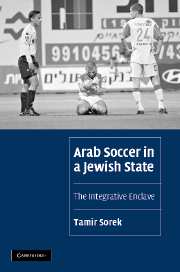Book contents
- Frontmatter
- Contents
- List of tables
- List of figures
- Preface and acknowledgments
- 1 Introduction
- 2 Sports, modernity, and struggle in Palestine
- 3 The emergence of the integrative enclave
- 4 Soccer and municipal “labor quiet”
- 5 “These points are Arab”: nationalist rhetoric in the sports press
- 6 “Maccabi Haifa is my flag”: Arab fans of Jewish teams
- 7 The Islamic Soccer League
- 8 Sakhnin – between soccer and martyrdom
- 9 Conclusion
- Appendix 1 Interviews with functionaries
- Appendix 2 Research design of the countrywide survey
- Appendix 3 Main findings from the countrywide survey
- Appendix 4 Research design of the survey in Sakhnin
- Appendix 5 Explanations for chapter 4
- Bibliography
- Index
- Cambridge Cultural Social Studies
Appendix 4 - Research design of the survey in Sakhnin
Published online by Cambridge University Press: 22 September 2009
- Frontmatter
- Contents
- List of tables
- List of figures
- Preface and acknowledgments
- 1 Introduction
- 2 Sports, modernity, and struggle in Palestine
- 3 The emergence of the integrative enclave
- 4 Soccer and municipal “labor quiet”
- 5 “These points are Arab”: nationalist rhetoric in the sports press
- 6 “Maccabi Haifa is my flag”: Arab fans of Jewish teams
- 7 The Islamic Soccer League
- 8 Sakhnin – between soccer and martyrdom
- 9 Conclusion
- Appendix 1 Interviews with functionaries
- Appendix 2 Research design of the countrywide survey
- Appendix 3 Main findings from the countrywide survey
- Appendix 4 Research design of the survey in Sakhnin
- Appendix 5 Explanations for chapter 4
- Bibliography
- Index
- Cambridge Cultural Social Studies
Summary
Sample: 174 male residents of Sakhnin aged 16 to 40 years were sampled by proportional geographical sampling (geographic borders in Sakhnin highly overlap with familial, class, and political divisions in the town (Rosenfeld and Al-Haj 1990). Sakhnin was divided into six sub-districts according to the division of statistical districts designed by the Israeli Central Bureau of Statistics based on the 1995 census. A proportional number of households were sampled in each district according to the absolute number of households within its boundaries. Interviewers were instructed to walk lengthways through the sub-district in pre-defined routes and to enter every 22nd house (Sakhnin had no street names or numbers in 1999). In each household they randomly selected one man in the appropriate age range (16–40). If there were two men within the appropriate age range in one household, interviewers were instructed to interview the elder the first time, the younger the second time, the elder the third time, and so on. In the case of three potential interviewees at a residence, interviewers were instructed likewise to select each time a different person in cyclical order of their age.
Data collection: The survey was conducted in April 1999. A structured face-to-face questionnaire-based interview was held with each one of the interviewees at their home. The two interviewers were male students from Sakhnin and the neighboring village of Deir Hana.
Dependent variables:
(1) Voting intentions in the elections for prime minister planned for May 29, 1999 (open question)
(2) Pride in belonging to eight identities: Sakhnin, the hamula (clan/extended family), the Palestinian people, the Arab people, the State of Israel, the religious group (Muslim or Christian), the Galilee region, and the men.
- Type
- Chapter
- Information
- Arab Soccer in a Jewish StateThe Integrative Enclave, pp. 204 - 205Publisher: Cambridge University PressPrint publication year: 2007

